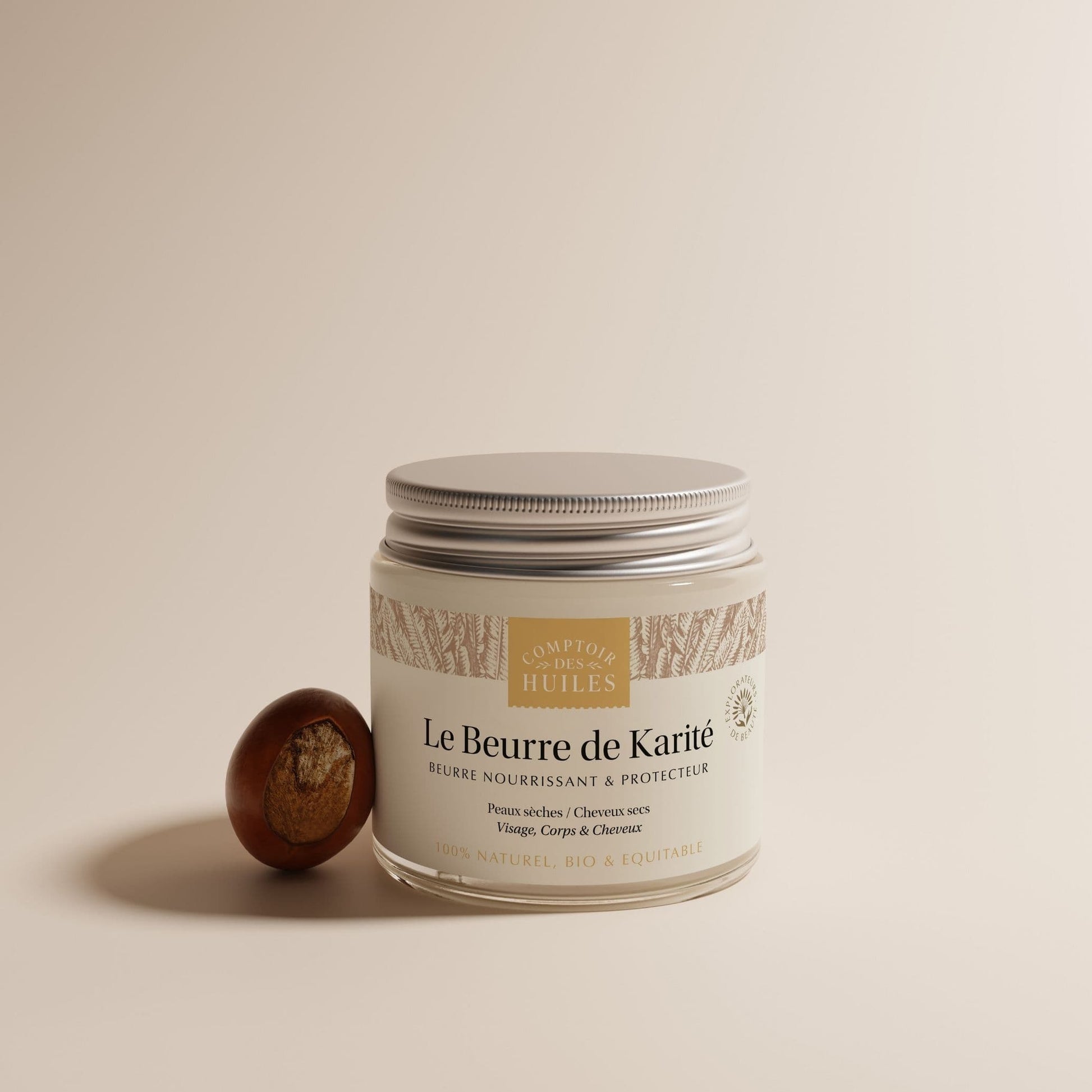The benefits of Shea Butter
Shea butter is a natural product widely recognized for its nourishing and moisturizing properties. Used for centuries in Africa for its medicinal and cosmetic properties, it is today an essential ingredient in many beauty products. Discover in detail the composition of Shea butter, its benefits for the skin and hair, as well as its various cosmetic uses.
What is the origin of Shea butter?
Shea butter , often nicknamed "women's gold" in Africa, is a precious natural ingredient that has its roots in the sub-Saharan regions of Africa. It is extracted from the nuts of the shea tree, scientifically known as Vitellaria paradoxa. This majestic tree can reach up to 15 meters in height and live for several centuries, producing its first nuts after around 20 years.
Harvesting shea is a laborious task that is generally done between the months of June and August. Shea nuts naturally fall to the ground when ripe. Once dried, the nuts are crushed to extract the kernels, which are then roasted and ground to obtain a paste. This paste is kneaded and heated to release the natural oils, which are then separated and filtered to produce raw shea butter. This traditional process, often passed down from generation to generation, ensures that shea butter keeps its beneficial properties intact.
Legend has it that iconic figures such as Cleopatra and the Queen of Sheba adopted Shea butter to preserve their beauty. Over time, shea butter has become an essential ingredient in many African skin and hair care traditions. It was in the 18th century that explorers rediscovered this precious substance with its remarkable properties, and a flourishing trade was established between Africa and Europe.
What is the composition of Shea butter?
Shea butter from Comptoir des Huiles is 100% natural, raw, pure, and certified ORGANIC by Ecocert, following the Cosmos standard. It is particularly appreciated for its rich and beneficial composition in:
- Vitamin A: Essential for cell regeneration, vitamin A helps maintain healthy, glowing skin. It is also known for its anti-aging properties and its ability to improve skin elasticity.
- Vitamin E: A powerful antioxidant, vitamin E protects the skin against damage caused by free radicals. It also helps hydrate and soothe the skin, reducing inflammation and signs of aging.
- Vitamin F: Composed primarily of essential fatty acids, vitamin F plays a crucial role in skin and hair health. It helps restore the skin's lipid barrier, promoting optimal hydration.
- Omega-3 and Omega-6: These polyunsaturated fatty acids are essential for maintaining the elasticity and suppleness of the skin. They also help reduce inflammation and promote healing.
- Phytosterols: Help stimulate the production of new cells, thereby promoting skin renewal and accelerating the healing of skin lesions
What are the benefits of Shea Butter for skin and hair?
Shea butter offers a multitude of benefits for the skin and hair, thanks to its composition rich in vitamins and fatty acids.
Its benefits for the skin:
- Intense hydration: Shea butter penetrates deep into the skin, providing intense, long-lasting hydration. It is ideal for dry and dehydrated skin.
- Anti-aging properties: With its high content of vitamins A and E, shea butter helps reduce the appearance of fine lines and wrinkles, while improving skin elasticity.
- Soothing irritation: The anti-inflammatory properties of Shea butter help soothe irritation, redness and itching, making it ideal for sensitive skin or skin prone to eczema and psoriasis.
- Protection against external aggressions: Shea butter forms a protective barrier on the skin, protecting it against environmental aggressions such as cold and pollution.
Its benefits for hair:
- Hydration and nutrition: Shea butter hydrates and nourishes dry and damaged hair, restoring shine and softness.
- Repairing split ends: By applying Shea butter to the ends of the hair, you can reduce split ends and prevent their formation.
- Protection against breakage: By strengthening the hair fiber, Shea butter helps reduce breakage and promote healthy hair growth.
What are the different uses of Shea Butter?
Shea butter can be used in multiple ways in beauty care routines.
Here are some of the most common uses:
For skin care:
- Moisturizing treatment: Use pure Shea butter as a daily moisturizing body lotion. Apply it after showering to seal in moisture.
- Lip balm: For soft, hydrated lips, apply a small amount of butter and blend in.
- Hand and foot cream: Apply Shea butter to your hands and feet to deeply moisturize them and soften rough areas. Massage your feet with the butter to make it penetrate well. Put on a pair of socks for the night, let it work and find regenerated skin in the morning.
- Aftershave Balm: Warm butter in the palms of your hands before applying to skin to soothe and moisturize after shaving, reducing irritation.
For hair care:
- Hair mask: Apply a generous amount of butter to your hair, focusing on the ends, and leave on for 30 minutes before rinsing and washing your hair.
- Leave-in serum: Melt a small amount of Shea butter between your hands and apply it to the lengths and ends of your hair to moisturize and protect it.
Shea butter is a natural ingredient with multiple benefits, providing deep hydration and nutrition for skin and hair. Its richness in vitamins and essential fatty acids makes it a versatile product, ideal for integrating into your beauty care routine. Whether you use it as a moisturizer, repairing balm or hair mask, Shea butter is a precious ally for healthy skin and hair.
Shea Butter
Shea butter is a versatile natural care for moisturize, soothe and protect the skin and/or hair against external aggressions. It is suitable for all skin types and particularly for dry, sensitive and mature skin.
- Deeply hydrates & nourishes
- Body and hair
- Nourishes and promotes hair shine
- 100% natural and certified ORGANIC

















